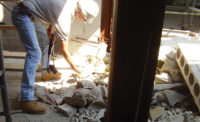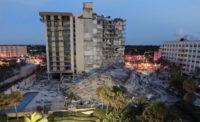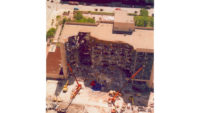The American Society of Civil Engineers Structural Engineering Institute has released the nation’s first consensus-based document specifically developed as a design aid for the resistance of disproportionate collapse in buildings and other structures. Ten years in the making, the shapers of ASCE/SEI 76-23 produced the historic performance standard from scratch.
The Standard for Mitigation of Disproportionate Collapse Potential in Buildings and Other Structures is intended to eliminate any doubt—and the long debate—about the difference between progressive and disproportionate collapse.
ASCE/SEI 76 defines disproportionate collapse as a collapse characterized by a “pronounced disparity between the original cause and the ensuing collapse of a major part or the whole of a structure.” Progressive collapse is by contrast “a collapse that commences with the failure of one or a few structural components and then progresses with the successive failures of other components.”
The standard is intended for owners and developers in the private sector that want their engineers “to add robustness” to their structures, says Donald Dusenberry, a consulting engineer and chair of the ASCE/SEI 76 committee. It is also intended to help building officials approve structures designed to mitigate disproportionate collapse.
The standard lays out the process for practitioners in the private sector who do not design for disproportionate collapse resistance on an “everyday basis,” explains Dusenberry.
It provides “a path to consistency and uniformity in practice,” he says. The tool allows, for the first time, “the vast majority of consultants" to look at disproportionate collapse mitigation in the same way, he adds.
In addition, scholarly papers and guides available to engineers do not offer a consensus-based perspective for mitigating disproportionate collapse. Standard 76 is the first.
Since Ronan Point
“Since the Ronan Point apartment building collapse in London in 1968, the structural engineering profession has engaged in serious discussion and research about causes and implications of widespread structural failure initiated by local damage,” notes the standard.
In the decades that followed, subsequent catastrophic structural failures, most significantly the 1995 truck-bomb destruction of Oklahoma City’s Alfred P. Murrah Federal Building, focused attention on disproportionate collapse. That "advanced the body of knowledge for enhancing robustness and limiting collapse from local damage," says the document.
The use of the standard is not required by the building code and “we don’t expect it to be,” says Dusenberry. But the committee hopes the document might make its way into the code as an appendix.
A Performance Standard
Existing documents intended to reduce disproportionate collapse from the U.S. General Services Administration and the Department of Defense offer prescriptive or a mix of prescriptive and performance-based approaches and “are not based on hard science,” says Michael Mudlock, the committee’s secretary and a principal of consulting engineer Simpson Gumpertz & Heger. As a performance standard, ASCE/SEI 76 “leaves it up to the designer to apply the principles and has a broader application than existing documents,” he adds.
The 79-page standard provides minimum requirements for planning, assessment, analysis, material selection, design and detailing, construction and qualification testing to mitigate disproportionate collapse of both new and existing buildings and other structures, excluding bridges. It includes threat-specific and non-threat-specific methodologies and identifies both direct and indirect design approaches.
The document does not prescribe requirements for blast design. That topic is addressed elsewhere, including in the recently updated standard—ASCE 59, Blast Protection of Buildings.
According to ASCE/SEI 76, “buildings and other structures shall be designed and constructed with adequate strength, ductility and deformation capacity and robustness to provide resistance to disproportionate collapse.”
Two Design Approaches
The standard offers two design approaches to demonstrate acceptable performance: Typical strength and robustness procedures, and, subject to the approval of the authority having jurisdiction for individual projects, alternative rational procedures, which “shall be demonstrated by analysis or by a combination of analysis and testing to provide a reliability not less than that expected for similar systems and connections" designed in accordance with typical strength, ductility, deformation capacity and robustness procedures.
ASCE/SEI 76 is currently available for download. Chapter one provides general requirements. Chapter two defines terminology. Chapter three lays out the requirements for a risk assessment. Chapter four offers ways to determine design objectives, including general initiating hazard scenarios and performance objectives. Chapter five presents technical approaches for the design of new buildings. It also offers tools to determine the capacity of existing buildings to resist disproportionate collapse and to develop upgrades for existing buildings.
Chapter six provides acceptance criteria for component and system performance, based on the selected analysis/design approach, construction materials and structural systems. Chapter seven provides minimum requirements and intents for structural detailing of various materials expected to be used as part of a disproportionate collapse mitigation strategy.
Chapter eight provides minimum requirements and discussion to evaluate and enhance the robustness of existing buildings and other structures. And chapter nine provides procedures and standards for peer review and the verification of the performance of selected components and structural assemblages.
Since 2013, there were more than 50 volunteers involved in the creation of the standard, which will be published in print form this summer.
“There was passionate discussion at times," says Mudlock, “even over a single word.”






Post a comment to this article
Report Abusive Comment